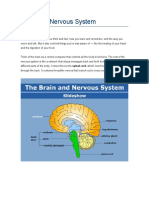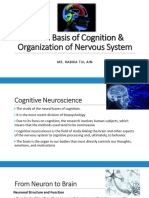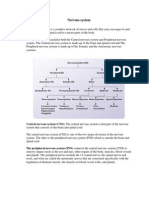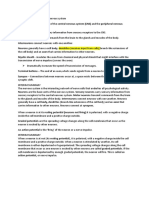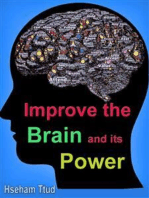Neurons: Cells of The Nervous System
Neurons: Cells of The Nervous System
Uploaded by
Itpixels OfficebackdoorCopyright:
Available Formats
Neurons: Cells of The Nervous System
Neurons: Cells of The Nervous System
Uploaded by
Itpixels OfficebackdoorOriginal Title
Copyright
Available Formats
Share this document
Did you find this document useful?
Is this content inappropriate?
Copyright:
Available Formats
Neurons: Cells of The Nervous System
Neurons: Cells of The Nervous System
Uploaded by
Itpixels OfficebackdoorCopyright:
Available Formats
Neurons: Cells of the Nervous System
neurons, act as the communicators of the nervous system. Neurons receive information, integrate it, and pass it along. They communicate with one another, with cells in the sensory organs, and with muscles and glands.
Parts of
neuron The highly branched fibers that reach out from the neuron are called dendritic trees. Each branch is called a dendrite. Dendrites receive information from other neurons or from sense organs. The single long fiber that extends from the neuron is called an axon. Axons send information to other neurons, to muscle cells, or to gland cells. What we call nerves are bundles of axons coming from many neurons. Some of these axons have a coating called the myelin sheath. Glial cells produce myelin, which is a fatty substance that protects the nerves. When an axon has a myelin sheath, nerve impulses travel faster down the axon. Nerve transmission can be impaired when myelin sheaths disintegrate. At the end of each axon lie bumps called terminal buttons. Terminal buttons release neurotransmitters, which are chemicals that can cross over to neighboring neurons and activate them. The junction between an axon of one neuron and the cell body or dendrite of a neighboring neuron is called a synapse.
The Nervous System
The nervous system is a complex, highly coordinated network of tissues that communicate via electro chemical signals. It is responsible for receiving and processing information in the body and is divided into two main branches: the central nervous system and the peripheral nervous system.
The Central Nervous System
The central nervous system receives and processes information from the senses. The brain and the spinal cord make up the central nervous system. Both organs lie in a fluid called the cerebrospinal fluid, which cushions and nourishes the brain. The blood-brain barrier protects the cerebrospinal fluid by blocking many drugs and toxins. This barrier is a membrane that lets some substances from the blood into the brain but keeps out others. The spinal cord connects the brain to the rest of the body. It runs from the brain down to the small of the back and is responsible for spinal reflexes, which are automatic behaviors that require no input from the brain. The spinal cord also sends messages from the brain to the other parts of the body and from those parts back to the brain. The brain is the main organ in the nervous system. It integrates information from the senses and coordinates the bodys activities. It allows people to remember their childhoods, plan the future, create term papers and works of art, talk to friends, and have bizarre dreams. Different parts of the brain do different things.
The Peripheral Nervous System
All the parts of the nervous system except the brain and the spinal cord belong to the peripheral nervous system. The peripheral nervous system has two parts: the somatic nervous system and the autonomic nervous system.
The Somatic Nervous System
The somatic nervous system consists of nerves that connect the central nervous system to voluntary skeletal muscles and sense organs. Voluntary skeletal muscles are muscles that help us to move around. There are two types of nerves in the somatic nervous system:
Afferent nerves carry information from the muscles and sense organs to the central nervous system. Efferent nerves carry information from the central nervous system to the muscles and sense organs.
The Autonomic Nervous System
The autonomic nervous system consists of nerves that connect the central nervous system to the heart, blood vessels, glands, and smooth muscles. Smooth muscles are involuntary muscles that help organs such as the stomach and bladder carry out their functions. The autonomic nervous system controls all the automatic functions in the body, including breathing, digestion, sweating, and heartbeat. The autonomic nervous system is divided into the sympathetic and parasympathetic nervous systems.
The sympathetic nervous system gets the body ready for emergency action. It is involved in the fight-or-flight response, which is the sudden reaction to stressful or threatening situations. The sympathetic nervous system prepares the body to meet a challenge. It slows down digestive processes, draws blood away from the skin to the skeletal muscles, and activates the release of hormones so the body can act quickly. The parasympathetic nervous system becomes active during states of relaxation. It helps the body to conserve and store energy. It slows heartbeat, decreases blood pressure, and promotes the digestive process.
Structure and Functions of the Brain
The brain is divided into three main parts: the hindbrain, the midbrain, and the forebrain.
The Hindbrain
The hindbrain is composed of the medulla, the pons, and the cerebellum. The medulla lies next to the spinal cord and controls functions outside conscious control, such as breathing and blood flow. In other words, the medulla controls essential functions. The pons affects activities such as sleeping, waking, and dreaming. The cerebellum controls balance and coordination of movement. Damage to the cerebellum impairs fine motor skills, so a person with an injury in this area would have trouble playing the guitar or typing a term paper.
The Midbrain
The midbrain is the part of the brain that lies between the hindbrain and the forebrain. The midbrain helps us to locate events in space. It also contains a system of neurons that releases the neurotransmitter dopamine. The reticular formation runs through the hindbrain and the midbrain and is involved in sleep and wakefulness, pain perception, breathing, and muscle reflexes.
The Forebrain
The biggest and most complex part of the brain is the forebrain, which includes the thalamus, the hypothalamus, the limbic system, and the cerebrum.
Thalamus
The thalamus is a sensory way station. All sensory information except smell-related data must go through the thalamus on the way to the cerebrum.
Hypothalamus
The hypothalamus lies under the thalamus and helps to control the pituitary gland and the autonomic nervous system. The hypothalamus plays an important role in regulating body temperature and biological drives such as hunger, thirst, sex, and aggression.
Limbic System
The limbic system includes the hippocampus, the amygdala, and the septum. Parts of the limbic system also lie in the thalamus and the hypothalamus. The limbic system processes emotional experience. The amygdala plays a role in aggression and fear, while the hippocampus plays a role in memory.
Cerebrum
The cerebrum, the biggest part of the brain, controls complex processes such as abstract thought and learning. The wrinkled, highly folded outer layer of the cerebrum is called the cerebral cortex. The corpus callosum is a band of fibers that runs along the cerebrum from the front of the skull to the back. It divides the cerebrum into two halves, or hemispheres. Each hemisphere is divided into four lobes or segments: the occipital lobe, the parietal lobe, the temporal lobe, and the frontal lobe:
The occipital lobe contains the primary visual cortex, which handles visual information. The parietal lobe contains the primary somatosensory cortex, which handles information related to the sense of touch. The parietal lobe also plays a part in sensing body position and integrating visual information. The temporal lobe contains the primary auditory cortex, which is involved in processing auditory information. The left temporal lobe also contains Wernickes area, a part of the brain involved in language comprehension. The frontal lobe contains the primary motor cortex, which controls muscle movement. The left frontal lobe contains Brocas area, which influences speech production. The frontal lobe also processes memory, planning, goal-setting, creativity, rational decision making, and social judgment.
Brain Hemispheres
Lateralization refers to the fact that the right and left hemispheres of the brain regulate different functions. The left hemisphere specializes in verbal processing tasks such as writing, reading, and talking. The right hemisphere specializes in nonverbal processing tasks such as playing music, drawing, and recognizing childhood friends. Roger Sperry, Michael Gazzaniga, and their colleagues conducted some of the early research in lateralization. They examined people who had gone through split-brain surgery, an operation done to cut the corpus callosum and separate the two brain hemispheres. Doctors sometimes use split-brain surgery as a treatment for epileptic seizures.
Control of the Body
Because of the organization of the nervous system, the left hemisphere of the brain controls the functioning of the right side of the body. Likewise, the right hemisphere controls the functioning of the left side of the body. Vision and hearing operate a bit differently. What the left eye and right eye see goes to the entire brain. However, images in the left visual field stimulate receptors on the right side of each eye, and in-formation goes from those points to the right hemisphere. Information perceived by the right visual field ends up in the left hemisphere. In the case of auditory information, both hemispheres receive input about what each ear hears. However, information first goes to the opposite hemisphere. If the left ear hears a sound, the right hemisphere registers the sound first. The fact that the brains hemispheres communicate with opposite sides of the body does not affect most peoples day-to-day functioning because the two hemispheres constantly share information via the corpus callosum. However, severing the corpus callosum and separating the hemispheres causes impaired perception.
Split-Brain Studies
If a researcher presented a picture of a Frisbee to a split-brain patients right visual field, information about the Frisbee would go to his left hemisphere. Because language functions reside in the left hemisphere, hed be able to say that he saw a Frisbee and describe it. However, if the researcher presented the Frisbee to the patients left visual field, information about it would go to his right hemisphere. Because his right hemisphere cant communicate with his left hemisphere when the corpus callosum is cut, the patient would not be able to name or describe the Frisbee.
The same phenomenon occurs if the Frisbee is hidden from sight and placed in the patients left hand, which communicates with the right hemisphere. When the Frisbee is in the patients left visual field or in his left hand, the patient may not be able to say what it is, although he would be able to point to a picture of what he saw. Picture recognition requires no verbal language and is also a visualspatial task, which the right hemisphere controls.
The Endocrine System
The endocrine system, made up of hormone-secreting glands, also affects communication inside the body. Hormones are chemicals that help to regulate bodily functions. The glands produce hormones and dump them into the bloodstream, through which the hormones travel to various parts of the body. Hormones act more slowly than neurotransmitters, but their effects tend to be longer lasting.
The pituitary gland, which lies close to the hypothalamus of the brain, is often called the master gland of the endocrine system. When stimulated by the hypothalamus, the pituitary gland releases various hormones that control other glands in the body. The chart below summarizes the better known hormones along with some of their functions.
Hormone
Produced by
Involved in regulating
Thyroxine
Thyroid gland
Metabolic rate
Insulin
Pancreas
Level of blood sugar
Melatonin
Pineal gland
Biological rhythms, sleep
Cortisol, Norepinephrine, Epinephrine, Adrenaline
Adrenal glands
Bodily functions during stressful and emotional states
Androgens
Testes (and ovaries and adrenal glands to a lesser extent)
Male secondary sex characteristics, sexual arousal in males and females
Estrogens
Ovaries (and testes and adrenal glands to a lesser extent)
Breast development and menarche in females
Progesterone
Ovaries (and testes and adrenal glands to a lesser extent)
Preparation of uterus for implantation of fertilized egg
You might also like
- Preparation in Psychology: Bicol University College of Engineering East Campus LegazpiDocument8 pagesPreparation in Psychology: Bicol University College of Engineering East Campus LegazpiKielNo ratings yet
- Chapter 3 Biological Basis of Behavior, Structure of Neurons and Nervous SystemDocument7 pagesChapter 3 Biological Basis of Behavior, Structure of Neurons and Nervous SystemAliaNo ratings yet
- (Lecture - 4) Neuropsychology of Human BehaviorDocument58 pages(Lecture - 4) Neuropsychology of Human BehaviorN. W. FlannelNo ratings yet
- What Is Neuron?Document8 pagesWhat Is Neuron?Shaekh Maruf Skder 1912892630No ratings yet
- Nervous SystemDocument7 pagesNervous SystemIhtisham Ul haqNo ratings yet
- The Nervous SystemDocument8 pagesThe Nervous Systemmuskaan.kukrejaNo ratings yet
- Brain and Nervous SystemDocument13 pagesBrain and Nervous SystemBrenda LizarragaNo ratings yet
- 3-Neural Basis of Cognition & Organization of Nervous SystemDocument36 pages3-Neural Basis of Cognition & Organization of Nervous Systemazharayesha64No ratings yet
- Module 7 Nervous SystemDocument18 pagesModule 7 Nervous SystemMisha WilliamsNo ratings yet
- Nervous SystemDocument8 pagesNervous Systemkitkat22phNo ratings yet
- Physiological Psychology ReviewerDocument13 pagesPhysiological Psychology ReviewerLeopando Rod CyrenzNo ratings yet
- Control, Coordination and Human BrainDocument8 pagesControl, Coordination and Human BrainSakshi SharmaNo ratings yet
- Nervou S System:: NeuronsDocument16 pagesNervou S System:: NeuronsFizzah100% (4)
- Brain and BehaviourDocument9 pagesBrain and BehaviourKenya BaileyNo ratings yet
- Grade 12 NotesDocument5 pagesGrade 12 Noteshafsag307No ratings yet
- Questions and AnswersDocument15 pagesQuestions and AnswersTanveerAli01No ratings yet
- Presentation Biology in Healthcare Stage4Document29 pagesPresentation Biology in Healthcare Stage4alanmauriciohdzNo ratings yet
- Anatomia e Sistema NerosoDocument8 pagesAnatomia e Sistema NerosoChloe BujuoirNo ratings yet
- CNS and PNSDocument4 pagesCNS and PNSDeepshikhaNo ratings yet
- Parts of The Brain and FunctionsDocument3 pagesParts of The Brain and FunctionsLee Ayn PoncardasNo ratings yet
- Nervous System - Overview: FunctionDocument11 pagesNervous System - Overview: FunctionAadil JuttNo ratings yet
- KSG-Brain ActivityDocument10 pagesKSG-Brain ActivitySyahirah ZackNo ratings yet
- How The Brain WorksDocument12 pagesHow The Brain WorksAbdullah B.No ratings yet
- The BrainDocument35 pagesThe BrainKuriok BurnikNo ratings yet
- Nervous SystemDocument34 pagesNervous SystemumeazabashaNo ratings yet
- General Biology 2 Finals ExamDocument32 pagesGeneral Biology 2 Finals ExamJohn Lloyd BallaNo ratings yet
- Nervous SystemDocument49 pagesNervous SystemJoyce NieveraNo ratings yet
- The Central Nervous System (CNS)Document4 pagesThe Central Nervous System (CNS)Giannelly Elizabeth Váscones VeraNo ratings yet
- The Nervous System Is A Complex Network of Nerves and Cells That Carry Messages To and From TheDocument18 pagesThe Nervous System Is A Complex Network of Nerves and Cells That Carry Messages To and From TheJanineLingayoCasilenNo ratings yet
- Relationship Between The Brain and The Nervous System - 2328 Words - Term Paper ExampleDocument4 pagesRelationship Between The Brain and The Nervous System - 2328 Words - Term Paper ExampleObi TomaNo ratings yet
- Anatomy of The Central Nervous SystemDocument7 pagesAnatomy of The Central Nervous SystemKristine AlejandroNo ratings yet
- The Central Nervous System: BrainDocument12 pagesThe Central Nervous System: BrainsheinelleNo ratings yet
- Nervous SystemDocument46 pagesNervous SystemMac Gab100% (3)
- Hes006 CNS Lab 15 18Document50 pagesHes006 CNS Lab 15 18Joana Elizabeth A. CastroNo ratings yet
- General Brain Structure N FunctionDocument6 pagesGeneral Brain Structure N Function'Niq Hdyn100% (1)
- Anatomy and PhysiologyDocument8 pagesAnatomy and Physiologymhel03_chickmagnetNo ratings yet
- Ms - Angeline M.SC (N) Previous Year Psychiatric Nursing Choithram College of NursingDocument79 pagesMs - Angeline M.SC (N) Previous Year Psychiatric Nursing Choithram College of NursingPankaj TirkeyNo ratings yet
- Reading 7 The Nervous SystemDocument16 pagesReading 7 The Nervous Systemlephuongvy1406No ratings yet
- Nervous SystemDocument3 pagesNervous SystemshhhNo ratings yet
- Discuss Action Potential of The Axon and Nerve ImpulseDocument3 pagesDiscuss Action Potential of The Axon and Nerve ImpulsePink PastaNo ratings yet
- CHP 7 Class 10Document13 pagesCHP 7 Class 10sourabh nuwalNo ratings yet
- Biological Basis of BehaviorDocument17 pagesBiological Basis of BehaviorAasma IsmailNo ratings yet
- c5730d07 Week 3 ss3Document4 pagesc5730d07 Week 3 ss3isabellaamelia54321No ratings yet
- 31.2 The Central Nervous SystemDocument28 pages31.2 The Central Nervous Systemmoniaguayo980% (1)
- OUR BODY Chapter - I (Science Class IV)Document4 pagesOUR BODY Chapter - I (Science Class IV)doultaniskNo ratings yet
- RP-Module 2Document24 pagesRP-Module 2Raksha ShettyNo ratings yet
- Psychology Week 3 NotesDocument9 pagesPsychology Week 3 Notes01234No ratings yet
- Biological Basis of Behaviour-IIDocument20 pagesBiological Basis of Behaviour-IIJaveria Zia100% (1)
- Nervous SystemDocument23 pagesNervous SystemSumaira Noreen100% (1)
- Nervous System - Summary NotesDocument9 pagesNervous System - Summary NotesHarshNo ratings yet
- The Cns Portfolio EditionDocument9 pagesThe Cns Portfolio Editionapi-438492450No ratings yet
- Nervous System SGDocument4 pagesNervous System SGNammywhammyNo ratings yet
- ANATOMYDocument4 pagesANATOMYChristine IgnasNo ratings yet
- Culasr NervoussystemDocument17 pagesCulasr Nervoussystemapi-318022661No ratings yet
- Nervous SystemDocument9 pagesNervous SystemalanNo ratings yet
- Gale Researcher Guide for: Overview of Physiology and NeuropsychologyFrom EverandGale Researcher Guide for: Overview of Physiology and NeuropsychologyNo ratings yet
- Master Your Mind: Neuroscience Secrets to Unlocking Your PotentialFrom EverandMaster Your Mind: Neuroscience Secrets to Unlocking Your PotentialNo ratings yet
- Human Body Book | Introduction to the Nervous System | Children's Anatomy & Physiology EditionFrom EverandHuman Body Book | Introduction to the Nervous System | Children's Anatomy & Physiology EditionNo ratings yet






